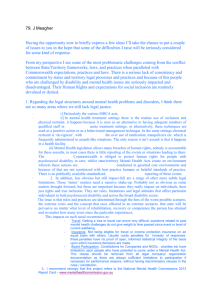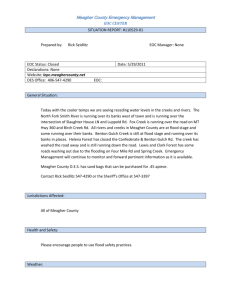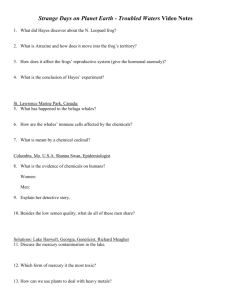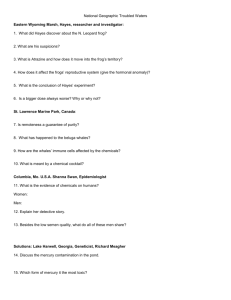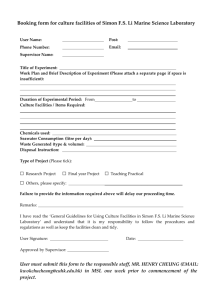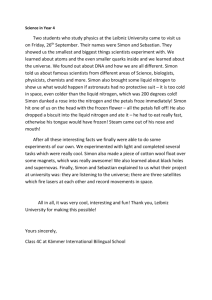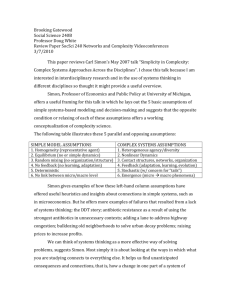BOOK REVIEW, PORTRAITS ON YELLOW PAPER, MARCH 2004(1)
advertisement
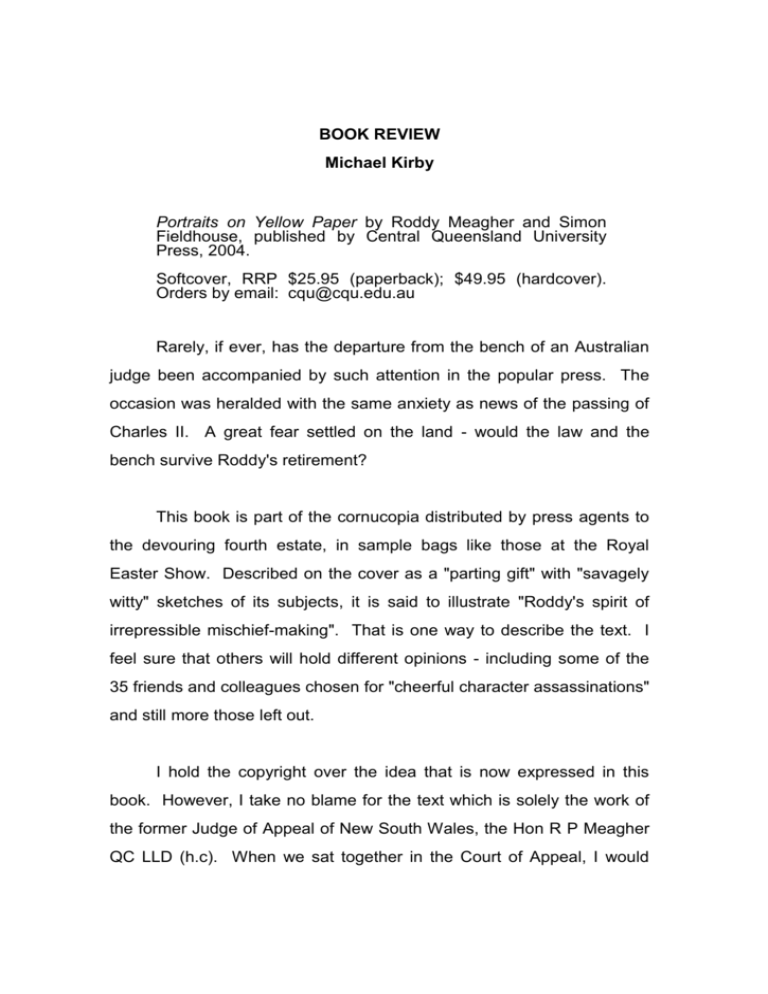
BOOK REVIEW Michael Kirby Portraits on Yellow Paper by Roddy Meagher and Simon Fieldhouse, published by Central Queensland University Press, 2004. Softcover, RRP $25.95 (paperback); $49.95 (hardcover). Orders by email: cqu@cqu.edu.au Rarely, if ever, has the departure from the bench of an Australian judge been accompanied by such attention in the popular press. The occasion was heralded with the same anxiety as news of the passing of Charles II. A great fear settled on the land - would the law and the bench survive Roddy's retirement? This book is part of the cornucopia distributed by press agents to the devouring fourth estate, in sample bags like those at the Royal Easter Show. Described on the cover as a "parting gift" with "savagely witty" sketches of its subjects, it is said to illustrate "Roddy's spirit of irrepressible mischief-making". That is one way to describe the text. I feel sure that others will hold different opinions - including some of the 35 friends and colleagues chosen for "cheerful character assassinations" and still more those left out. I hold the copyright over the idea that is now expressed in this book. However, I take no blame for the text which is solely the work of the former Judge of Appeal of New South Wales, the Hon R P Meagher QC LLD (h.c). When we sat together in the Court of Appeal, I would 2. occasionally relieve a seriously tedious case by sketching my colleagues in the Court and the more exuberant barristers appearing before us. Those who find this pastime difficult to believe can read about it in the essay on me in this collection. Indeed, it is just about the only factually accurate thing recorded there. By the time we were separated judicially, I had the portly sketch of R P Meagher down to a tee. Handley JA always appeared with a halo above his head to mark his manifest saintliness, a point picked up with typical under-statement in the essay on him. The declaiming barristers were captured in every mood. I knew that Meagher JA appreciated, indeed collected, these sketches. It is sad to read that they were stolen or lost. But in the chaos of his old judicial chambers, anything could have happened. I was not asked to supply the likenesses appearing in this book. Reading the text of several of the entries convinces me that it was prudent to have missed out. Instead, the fine pen drawings are by Simon Fieldhouse. They are first class and better by far than my half remembered efforts. Judy Cassab, the famous portraitist, told me once (whilst putting a dab of grey paint where my eye was to be) that getting a likeness of the human face is a special gift, not afforded to every artist. When very young, she discovered that she had that gift. Simon Fieldhouse has hitherto been renowned for marvellous architectural drawings. They are much beloved of lawyers. This is possibly because Simon was himself once trained in law and offers drawings of legal buildings and scenes, 3. captured with a brilliant eye for detail. Lawyers tend to like his sense of order, precision, accuracy and wry humour. Usually, hidden away in some corner (like Alfred Hitchcock in his movies), is a whimsical form, occasionally semi-human - just to show that Simon Fieldhouse does not take the form of things as seriously as might appear. Perhaps like any good modern lawyer he knows that substance will trump form every time. Yet, in the past, the human forms in his work have been strictly incidental. The main purpose has generally been to portray, with infinite patience, the details of this world - bricks, stones, books and things, not people. R P Meagher has enjoyed a long friendship with the artist - as he has with many other people in the arts world. Several of them are selected for portrayal in this book. But its great artistic merit is that it illustrates the growing talent of Simon Fieldhouse in capturing the likeness of human subjects. Some of the efforts are singularly good. I would mention the portrayal of Meagher himself in full bottom wig, of Handley in like regalia, of Justice Patricia Bergin of the Supreme Court of New South Wales, of Dame Leonie Kramer and George Cardinal Pell. Simon Fieldhouse's technique is common amongst artists these days. If his effort on me is any guide, it involves sketches and photographs, all absorbed into the final product. These are splendid examples of the draughtsman's art. It appears that the artist feels most comfortable with side images - as if unwilling to confront his subjects face on. My own portrayal looks accurate enough - even kind, especially 4. by comparison to the text. I am shown facing a rhinoceros which Fieldhouse draws with Dürer-like accuracy. Naturally, I thought it a metaphor for confronting ancient and seemingly insuperable odds. An unkind spark, however, suggested that the words "a hide as thick as" sprung to mind. I do not believe that any of the subjects will be upset with their portrayal by Fieldhouse. The main contours of the personalities are captured without too many tell-tale wrinkles. For example, Justice Callinan, a close friend of Roddy Meagher, is portrayed in a benign and youthful pose, as if someone has got to his visage with a gallon of botox. Such skills could make the artist even more in demand in wealthy legal circles and for this newly displayed talent. These are sketches that rise far above cartoons. They are fine works of an excellent Australian artist. Just for them it is true to say, as the cover blurb puts it, that "this book is a collector's item". The text, at least on the legal personages recorded in the book, is quite another matter. Excerpts from it were leaked to the press in the weeks and days prior to the author's judicial retirement. The choicest bits were published and republished in financial newspapers, building up a frenzied anticipation of what more could be said at the farewell sitting of the Supreme Court of New South Wales. Like many others, I thought it prudent to be present on that occasion. Never has the Banco Court in Sydney seen such a crush. And the overspilling members of the legal profession received their money's worth. The humorous speeches of 5. Spigelman CJ, Mr Ian Harrison SC (President of the Bar) and Meagher JA himself set a record in that genre that will probably never be matched. Some old timers, like this reviewer, muttered that it might be time to return a little closer to the past balance of solemnity that formerly marked such occasions. But this was a minority opinion on the day. As I listened to the humour of the ceremony, I reflected on the great popularity of Roddy Meagher amongst the New South Wales Bar. The truth is that he is, and always has been, one of them. He was an excellent advocate. I know this because he appeared before me prior to his appointment to the bench. He thought like a judge, even when he was at the Bar Table. He was nimble of mind. He was witty without presumption. He knew the winning point, if there was one. He was conservative, gossipy, but cultured and well mannered. At the ceremony these virtues were on dazzling display. He tapped the reservoir of male bonding. In varying degrees, they are present in this book. The "victims" are mostly the author's friends and acquaintances who come to the realisation, early in the relationship, that there is a price to be paid for Meagherian friendship. Pretty clearly, his great love is art. He has contempt for the lawyers (including this reviewer) who are not as passionate about art as he. He recognises that, important as laches, springing uses and precatory trusts may be, they pale into insignificance beside the creative arts, and in particular painting, water colours and drawings. In the Court of Appeal I was the happy beneficiary of the many masterpieces that he scattered around the Chambers walls. He 6. chose a portrayal of copulation by Brett Whitely for the wall immediately outside my Chambers to shock the Protestant Anglican divines who would visit me there. Justice Mason quickly removed it - doubtless an explanation for his omission from this book. Like all the author's friends, I found it easier to just go along with the mischief. There are few, if any, unkind shafts in the essays on artists (such as Margaret Olley, Simon Fieldhouse and the author's beloved late wife Penny). The same is true of art publishers (Lou Klepac), arts administrators (Edmund Capon) and art gallerians (Robin Gibson and Brian Moore). He is even relatively gentle on politicians (John Howard), the Cardinal, stray medical practitioners, composers (Terry Clarke and Ross Edwards) and fellow bridge players. However, it is when Roddy Meagher turns to his colleagues in the legal profession that bile can be detected. It is pointless to complain about inaccuracies over the facts. He suggests, in two places, that I was an adviser to the Hon E G Whitlam during his government. This and other factual claims about me are false. Heaven knows the errors about other people that will now be retold as gospel. There are obvious typos. Michael Connors is described as a "Paul Haines Fellow" whereas the distinction in Rotary is named for the founder, Paul Harris - whose fame has obviously not reached the author's consciousness. If this is forgivable, the description, in the essay on Sir Laurence Street, of "A S Mason" lecturing law students in equity is not. The former Chief Justice's middle name is Frank. Yet these are nitpicking concerns. 7. Several of the descriptions of the lawyers portrayed ring true. Often, however, they are marred by unnecessary nastiness, usually directed at someone else. Named judges are portrayed as mediocrities, as "dullards", their writings "arid", their minds incapable of creativity, their judgments pioneers of "verbless sentences" etc etc. Occasionally such castigation is humorous, at someone else's expense. But it reminds me of some of the writing of Roddy Meagher's close relative, the Nobel laureate Patrick White. Meagher reveals that his mother was constantly distressed that the family was related to Patrick White. He attacks White's shafts of personal unkindness. Yet the same traits are there in his own writing. Perhaps it is genetic. No doubt it helps to sell books. It seems unlikely to win this author a Nobel prize for literature. It treads a fine line between verbal cleverness and embarrassing hurt to people whose good qualities are forgotten as the stiletto is driven home. Then there is the put down of women. One highly talented woman is simply "a good sort". Someone's current wife is a "pretty little thing". Another preaches "never shaving her legs". These are relics of an old culture, learned in boys-only schools that dominated the legal profession for centuries and captured R P Meagher when a youth. As Ian Harrison said at the farewell ceremony in the Banco Court, such attitudes can sometimes be an extra burden for women lawyers struggling with a practice, children and new worlds to conquer. It has always been a puzzle to me that a man so brilliant and personally kind can occasionally 8. err in such judgments. It is odd because he always seems most at ease in the company of women. There will never be another Roddy Meagher. He would say that it is contemporary political correctness that breaks the mould of people like himself. Others would say that it is the application of mind and heart to the world of others that produces the change of culture. It is therefore just as well that this book has now been published. Simon Fieldhouse's art work is brilliant. Much of the text is interesting, sharp, charming and pleasingly witty. If there are other parts of the prose that are less worthy, it is simply the result of the "package" that is Roddy Meagher. Brilliant and sensitive. Sharp and nasty. Old and wise, but ever the private school-boy. Gregarious and cultivated. Shy and complex. His are the features of many legal practitioners in Australia, writ large. The talents of Patrick White, tamed somewhat (but not very much) by a life in the law and on the bench. Whether there is a market Australia-wide for this book remains to be seen. How they would respond to it in Derby, Tennant Creek and Temora, where Roddy was born, is doubtful. Whether there will be a second edition with more "victims" is a subject on many lips. Whether writs will flow is hotly contested. This is distilled Meagher illustrated by Simon Fieldhouse in a new phase of his artistic career. Meagher filled the Banco Court in Sydney to overflowing. The book will quickly sell out. Purchasers, if they have any sense, will get copies autographed by author, artist and victims alike. In a decade, it is safe to predict, this 9. book will either be priceless or forgotten. Lawyers will take it from their shelves. I am certainly glad to have my copy. BOOK REVIEW Michael Kirby Portraits on Yellow Paper by Roddy Meagher and Simon Fieldhouse, published by Central Queensland University Press, 2004. Softcover, RRP $25.95 (paperback); $49.95 (hardcover). Orders by email: cqu@cqu.edu.au
